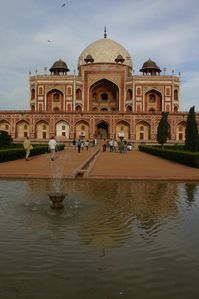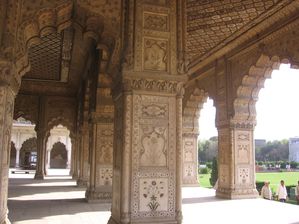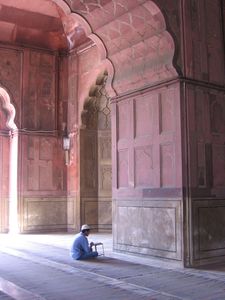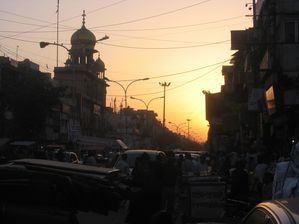Dilli, Second Part...
En 1526, Babur, empereur moghol, débarque avec ses troupes et s’empare de la ville afin d’y étendre son empire qu’il contrôle depuis Agra. « C’est parti pour une dynastie moghole ! » me direz-vous ? euh… non, pas encore, la ville fut reprise au fils de Babur, Humayun, par Sher Shah Suri. Ce dernier envoya Humayun se ballader, ou plutôt, en exil, en Afghanistan puis en Perse, histoire d’être tranquille pour construire sa ville à lui : Purana Qila ! A sa mort son fils pris les rênes du royaume puis ce fut au tour de Hem Chandra Vikramaditya, Hemu pour faire court, Chef des armées qui pris le contrôle de Delhi dans le but d’en faire un royaume hindou à nouveau, eh ben raté…
Car qui aperçois-je au loin, tout petit sur sa monture, fier, les cheveux au vent ? Vous aussi vous l’avez reconnu, mais si, c’est bien lui, c’est Akbar (le grand)! Sacré Akbar, grâce à lui, la dynastie moghole est de retour et pour un petit moment… Le premier monument moghol à apparaître à Delhi fut le tombeau d’Humayun, mis en chantier par sa femme et dessiné par un architecte perse vers 1564. C’est sans conteste un des plus beaux modèles de mausolées qui existent en Inde, il inspira d’ailleurs fortement l’architecture du Taj Mahal. Il fait partie de la liste de l’UNESCO comme Patrimoine Mondial de l’Humanité depuis 1993.

La ville pris le nom (eh oui ! encore une fois !) de Shahjahanabad, en référence à Shah Jahan, descendant d’Akbar, qui laissa une trace conséquente de son passage. On lui doit notamment le Red Fort ou Lal Qila ainsi que Jama Masjid, monuments majestueux qu’il fit construire avant de transférer la capitale de son empire à Agra.
Le Fort Rouge fut bâtit entre 1639 et 1647 dans l’actuel Old Delhi. Cette citadelle-palais de grès rouge renferme de magnifiques jardins, terrasses, pavillons, salles d’audiences fabriqués eux en marbre blanc.

Non loin de là, dans l’incroyable quartier de Chandni Chowk, trône la Grande Mosquée (1644-1658). Jama Masjid ou Mosquée du Vendredi, c’est la plus grande mosquée de l’Inde, c’est dire ! Construite elle aussi en grès rouge et marbre blanc, c’est un des projets les plus ambitieux et imposants de la ville. Il faut se poser dans sa cour pour observer les gens qui passent et admirer l’architecture, ou bien grimper le seul minaret visitable pour observer le vieux Delhi d’en haut. Ah oui, par contre les femmes n’ont pas le droit d’y monter si elles ne sont pas accompagnées ! L’escalier en colimaçon est très étroit et une fois en haut, Dieu sait ce qui peut se passer (si je peux me permettre…), les hommes dans ce pays n’étant pas très faciles à canaliser, et oui, même dans une mosquée !

Nader Shah mis un terme à tout cet art et ces magnifiques constructions quand il s’empara de Old Delhi et saccagea la ville en 1739. En ces temps, c’est l’empire moghol tout entier qui allait mal. Après le règne d’Aurangzeb, les territoires qui avaient été précédemment conquis par Akbar pour la plupart, partaient en lambeaux. Attaqué de toutes parts, l’empire agonisait… Et le roi persan, après s’être emparé des richesses mogholes, et notamment du « Koh-I-Noor », le plus gros diamant taillé et le plus pur (aujourd’hui sur un collier de la reine d’Angleterre), s’en alla comme il était venu !

Les Marathes, population du Sud, après d’incessantes batailles reconquirent peu à peu les terres mogholes et étendirent à leur tour leur empire dans l’Inde du Nord et du centre. Mais les moghols restèrent officiellement « maîtres de Delhi » jusqu’en 1857. Ils demandèrent même l’aide des Britanniques pour lutter contre ces envahisseurs du Sud, manque de bol un envahisseur peut en cacher un autre ! Et une fois l’empire Britannique installé, les rois furent laissés bien à l’abri dans leur palais, maintenus à l’écart des affaires du pays…
In 1526, Babur, Mughal Emperor, landed with his troops and captured the city in order to expand his empire he controls from Agra. "Let's go for a Mughal dynasty! " You say? uh ... no, not yet, the city was taken to the son of Babur, Humayun, by Sher Shah Suri. The latter sent Humayun to walk, or rather, in exile in Afghanistan and then Persia, in order to quietly build his city: Purana Qila! At his death his son took over the kingdom and it was the turn of Hem Chandra Vikramaditya, Hemu for short, Chief of the armies who took control of Delhi in order to make it a Hindu kingdom again, well, missed ...
Hey, who do I see, coming from far, tiny on his horse, proud, his hair in the wind? Yes, you know him, that’s Akbar (the great)! Ah, Akbar, thanks to him, the Mughal dynasty is back for a while ... The first Moghul monument in Delhi to appear was the tomb of Humayun, begun by his wife and designed by an architect Persian in 1564. This is undoubtedly one of the most beautiful models of shrines that exist in India, it also greatly inspired the architecture of the Taj Mahal. It is part of the list of UNESCO as World Heritage of Humanity since 1993.

The city took the name (yes again!) of Shahjahanabad, referring to Shah Jahan, the descendant of Akbar, who left a substantial mark of its passage. He was responsible for the Red Fort or Lal Qila and Jama Masjid, majestic monuments he built before transferring the capital of his empire to Agra.
The Red Fort was built between 1639 and 1647 in the current Old Delhi. This fortress-palace of red sandstone contains magnificent gardens, terraces, pavilions, courtrooms made in white marble.

Nearby, in the amazing area of Chandni Chowk, stands the Great Mosque (1644-1658). Jama Masjid or Friday Mosque is the largest mosque in India, that is to say! Was also built in red sandstone and white marble, is one of the most ambitious and impressive monument in the city. One must sit in his court to observe the people passing by and admire the architecture, or climb the only minaret visited to observe the Old Delhi from above. Ah yes, women are not allowed to step on it if they are not accomp anied! The spiral staircase is very narrow and once on top, Lord knows what can happen (if I may ...) men in this country are not very easy to channel, and yes, even in a mosque! Shameful…

Nader Shah put an end to all this art and these magnificent buildings when he captured the Old Delhi and sacked the city in 1739. In these times, it is the whole Mughal empire that went wrong. After the reign of Aurangzeb, the territories that had previously been conquered by Akbar for the most part, left in tatters. Attacked from all sides, the empire was dying ... and the Persian king, after seizing the Mughal treasures, including the Koh-I-Noor ", the largest cut diamond and the purest (now a Necklace of the Queen of England), went as he came!
The Marathas, southern population, after incessant battles gradually reconquered lands of Mughals and expanded their empire in northern India and the center. But the Mughals remained officially "masters of Delhi” until 1857. They even asked for British help fight against these invaders from the south, but unfortunately an invader may hide another! And once the British Empire was installed, the kings were left well protected in their palace, kept away from affairs of the country ...
